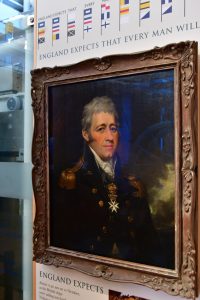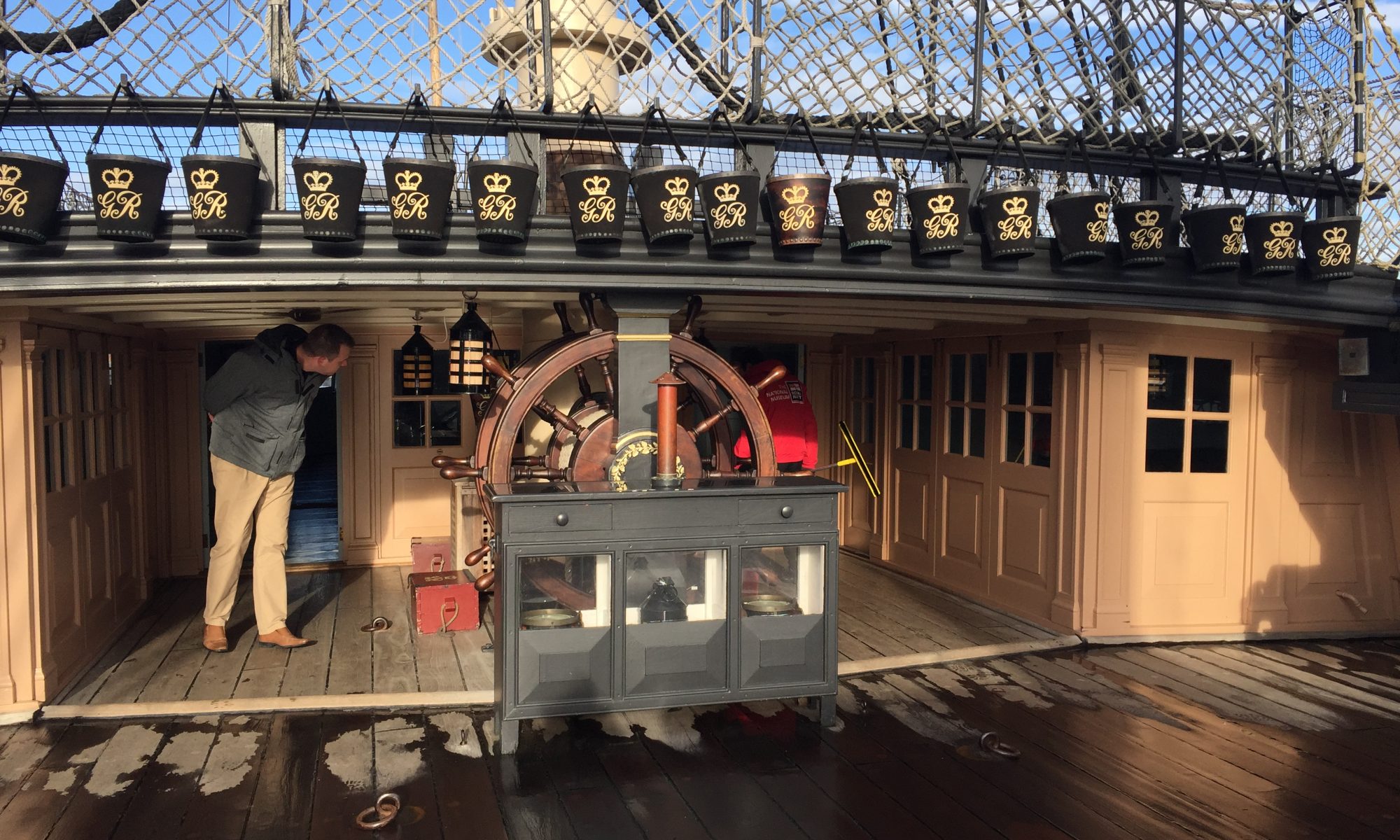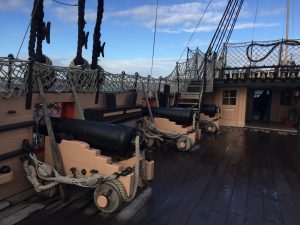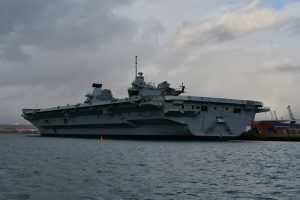 The Historic Dockyard at Portsmouth is more than just a museum. It is a site containing a collection of museums, all of them connected to the Royal Navy and Britain’s maritime heritage and you need more than one day to do all of them. Since we only had one day and since the aim of my visit was to soak up some background information about naval warfare and life in the 19th century navy, I was very specific about the museums we chose but we had time for one or two extras and I will definitely be back to do the rest. This place is absolutely brilliant.
The Historic Dockyard at Portsmouth is more than just a museum. It is a site containing a collection of museums, all of them connected to the Royal Navy and Britain’s maritime heritage and you need more than one day to do all of them. Since we only had one day and since the aim of my visit was to soak up some background information about naval warfare and life in the 19th century navy, I was very specific about the museums we chose but we had time for one or two extras and I will definitely be back to do the rest. This place is absolutely brilliant.
We went first to visit HMS Victory, the flagship of Admiral Lord Nelson at the battle of Trafalgar. She is looking a little odd at the moment since a new phase of restoration and conservation is taking place, and the top half of her masts is missing. Despite that, there is no way that this ship can look anything other than impressive and beautiful.
HMS Victory left the Chatham Royal Dockyard in 1765. Over an unusually long time in service she would lead fleets in the American War of Independence, the French Revolutionary War and the Napoleonic War and in 1805 she achieved lasting glory as the flagship of Vice-Admiral Nelson at Trafalgar when Britain defeated the French and Spanish fleet in what is often seen as Britain’s greatest naval victory.
In 1808 the Victory was re-commissioned to lead the fleet in the Baltic. Four years later, no longer required in this role she was relegated to harbour service as a residence, flagship and tender. In 1922 she was saved for the nation and placed permanently into dry dock where she is today visited by millions of visitors from around the world; a museum of the sailing navy and the oldest commissioned warship in the world.
For me, the Victory was a chance to step aboard a warship of the age. My current work-in-progress, An Unwilling Alliance, is about a Manx sea captain who survived Trafalgar and has just been given command of his own warship. The Iris, Hugh’s ship, is not as big as the Victory, being a third rate 74 gun ship, but there is still a strong sense of what life might have been like aboard such a ship and the task of writing about the Iris and its crew suddenly feels more manageable.
The Victory is set up to give a very good sense of life aboard a warship. Sections of the lower deck have hammocks set up and some of the tiny officers and midshipmen’s cabins are furnished as they would have been at the time. You can see the captain and admiral’s quarters and it is fascinating to see how the crew slept and lived alongside the guns. With a battle approaching, furniture would be cleared away and the entire area would become a battleground.
Naval battles at this time were not just about the pounding of heavy guns. Ships fought close together and sailors and marines fired muskets and pistols at the enemy crew as if in a land battle. Nelson’s fatal wound at Trafalgar was caused by a shot down from the enemy rigging which shattered his spine. Once ships were close together the aim was to board the enemy ship and close and savage hand to hand fighting with sword, bayonet and axe would ensue. The ship’s guns did not fire exploding shells, they acted as battering rams, smashing the enemy ship to pieces, and a lot of the wounds treated by the ship’s surgeon came from wooden splinters which could be lethal.
One of the big assets of this museum are its guides. Most are volunteers, often former navy personnel and their knowledge and enthusiasm for their subject is very impressive. These are not people who have done a bit of background reading on the subject; they know it all. We spent a fair bit of time chatting, not just about the Victory and the Napoleonic wars but about other ships and other combats. It would be easy to spend a day just talking to them.
If there is a downside to the Victory, it is the lack of written information. There is a guidebook and an audio-guide. I’m not a fan of either as I find wandering around with a book in my hand or listening through headphones detracts from the experience for me, so initially I found the complete absence of any kind of information boards irritating. I quickly realised that there was always a guide close by to ask, and they always know the answer, but if you’re not one to start talking freely to complete strangers, make sure you get a guide of some kind before you board or you’ll miss out.
The other thing to be aware of, is how low the lower decks are. We were told that some of the warrant officers were six feet or more and it must have been an enormous strain working below decks at that height. At 5’6” I had to stoop a fair bit and my 6’ husband had a backache by the end of the tour.
Having said that, it was a completely brilliant experience and I would recommend it to anybody.
 National Museum of the Royal Navy
National Museum of the Royal Navy
There is a lot of this, it needs plenty of time. The museum is in two parts, one dedicated primarily to Nelson and his war and the rest covering the history of the Royal Navy up to modern times, including a fabulous exhibition about women and their role in the navy, especially the history of the WRENs. It’s a great museum, well-set out with a huge amount of information and something for everybody. We had to rush some parts of it, so be warned and give it time.
This boat trip around the harbour is included in the price of the museums and is well worth doing. It takes about 45 minutes and looks at the history of Portsmouth as a naval base as well as taking a look at any modern Royal Navy vessels that happen to be in port at the time. This was a treat for us as it gave us the chance to get a very good look at the brand new Queen Elizabeth aircraft carrier which is astonishing. There were a couple of great photo ops including the Victory – the old and the new navy side by side. Well worth doing but wrap up warmly if you’re doing it in January…
This was my bonus treat of the day. Completely out of my period, but the skeletal remains of Henry VIII’s flagship, raised from the Solent and preserved along with many artifacts, is one of the most haunting sights I have ever seen. The museum is very new and combines the history of the ship and its sinking with the story of its recovery very effectively. The technology used to display the ghostly hulk of the Mary Rose, with images of its daily life projected onto it, is impressive. I can remember following this story as a history student back in the eighties and what they’ve done since then defies belief. Along with the Victory, this has to be the highlight of the Dockyard and is one of the most incredible things I’ve ever seen, so atmospheric. Go and see it.
The Mary Rose was the end of our day. I plan to come back and spend a few days in Portsmouth. I want to see the rest of the historic dockyard: there is a lot more to see, including the Victorian HMS Warrior, the Submarine Museum, HMS M.33 and several other attractions that I didn’t have time to explore. This would be an excellent place to visit with children, they have their own dedicated play areas but the exhibits themselves are very much designed for all ages. Mine are older now but they would have loved this place. I would also like to spend time looking at the town itself. I definitely got what I came for, but I want more.
I’ve been worried about taking on the mammoth task of writing about the navy in 1807 when I feel so much more comfortable with the army, but Portsmouth Historic dockyard is a big step forward for me. After months of reading and making notes I suddenly feel that I’ve got a sense of my locations in the same way I did when I stood on the walls of Ciudad Rodrigo in Spain. Writing the navy is very different; although they lived and loved on shore, when they went to work they did it in a small space, bound by wooden walls but with the ocean all around them. That must have shaped the character of the men who fought and died with Nelson and I’m looking forward to getting to know some of them better.
An Unwilling Alliance is due for publication in April 2018.


 HMS Victory
HMS Victory Harbour Tour
Harbour Tour